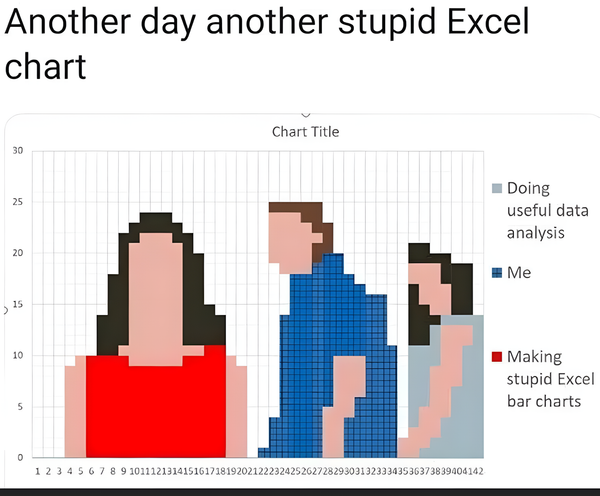The One On Productivity
We all want to be more productive, but your 5th TODO app is not the answer

Everyone's talking about being super productive these days. But is this actually a good thing?
Recent studies show that while we're getting more stuff done, we're also feeling more burnt out and less happy at work. It's like we're so busy being busy, we forget to actually enjoy our work.
Here’s a new approach: balance.
- Redefine Productivity: Shift focus from mere output to value creation. Encourage tasks that foster creativity and teamwork.
- Encourage Regular Breaks: Contrary to the 'always-on' myth, breaks boost productivity. They're not a sign of weakness, but a strategic tool for long-term efficiency.
- Promote a Culture of Well-being: Create an environment where mental health is as prioritized as deadlines. This could mean offering flexible hours, mental health days, or simply fostering open conversations about stress and workload.
And, while we’re at it, let’s see a couple of techniques that actually work with focus and time management, which directly affect productivity.
🍅 The Pomodoro Technique ⏲️
You've probably heard of the Pomodoro Technique. It's a simple time management method that's been around since the late 1980s, but it's still making waves in productivity circles. So, what's the deal with it?
The core idea is straightforward: you work for 25 minutes straight (that's one “Pomodoro”), then take a 5-minute break. After four Pomodoros, you take a longer break of 15–30 minutes. Sounds simple, right? But it's not just about breaking time into chunks. It's about the psychology of productivity.
- Focused Work Sessions: 25 minutes is short enough to stay focused and long enough to get something substantial done.
- Regular Breaks: These keep your mind fresh and prevent burnout. Think of it like interval training for your brain.
- Manageable Goals: By breaking your workday into Pomodoros, tasks feel less overwhelming. You're not climbing a mountain; you're just taking a step.
But here's the real question: Does it actually work? For many, absolutely. It instills discipline, helps manage distractions, and can improve concentration. However, it's not one-size-fits-all. Some find the frequent breaks disruptive, especially for deep, creative work.
🧠 The Eisenhower Matrix
In our quest for better time management, there’s a tried-and-true tool that still holds its ground: The Eisenhower Matrix. This simple yet powerful method, named after President Dwight D. Eisenhower, helps prioritize tasks by urgency and importance.
Here's how it breaks down:
- Urgent and Important (Do First): These are your critical tasks that need immediate attention. Think deadlines and emergencies.
- Important, Not Urgent (Schedule): These tasks are important for your long-term goals, but don’t need to be done right away. Plan to do these later.
- Urgent, Not Important (Delegate): These are the tasks that need to be done soon but don't necessarily require your specific skill set. If possible, delegate them.
- Neither Urgent Nor Important (Eliminate): These are the distractions or low-value activities. Ideally, these should be cut from your schedule.
Sounds straightforward, but why is it so effective?
- Clear Prioritization: It helps you see what needs your attention now and what can wait.
- Focus on What Matters: By identifying tasks that align with your long-term goals, you focus more on meaningful work.
- Reduces Overwhelm: By categorizing tasks, it becomes easier to manage your to-do list and feel less stressed.
However, it's not without its challenges. Some find it difficult to differentiate between urgent and important tasks, while others struggle to let go of control and delegate.

❌ The Seinfeld Strategy
You might know Jerry Seinfeld for his comedy, but did you know he's also inadvertently behind a popular productivity hack? It's called the Seinfeld Strategy, and it's surprisingly simple yet effective for building consistency and discipline in any area of your life.
Here's the gist of it:
- Choose a Task You Want to Consistently Perform: This could be anything — writing, exercising, learning a new skill.
- Get a Big Wall Calendar: Place it somewhere you can’t ignore.
- Mark an X for Each Day You Do the Task: The goal is to create a chain of Xs. Seeing this chain grow is surprisingly motivating.
- Don’t Break the Chain: The longer the chain, the more it motivates you to keep going.
Why does this work so well?
- Visual Motivation: Seeing a chain of successes is a powerful motivator. It turns abstract goals into something tangible.
- Simplicity: It’s not about tracking progress in detail, just maintaining a habit.
- Flexibility: It can be applied to virtually any task or goal.
- Accountability: It forces you to confront your consistency (or lack thereof).
However, it’s not foolproof. Life happens, and every so often the chain breaks. The key is not to get discouraged, but to start a new chain.

3️⃣ The 3/3/3 Technique
Feeling swamped by your to-do list? The 3/3/3 technique might be your lifesaver. It's a no-nonsense way to tackle your day without getting overwhelmed.
Each day, aim to accomplish three main categories of tasks:
- Spend 3 hours on deep work tasks that require your full attention and contribute significantly to your goals.
- Complete 3 smaller tasks or attend meetings that are necessary but less intensive.
Perform 3 maintenance activities, like checking emails or organizing your workspace, to stay organized and in control of your responsibilities.
Why try it?
- It’s Simple: Just 3 tasks at a time. Easy to remember, easy to do.
- It’s Flexible: Fits any kind of task, work or personal.
- It Helps You Focus: You're only dealing with 3 tasks at once, so it’s less stressful and more doable.
The catch? It might be too rigid for some. And figuring out which tasks to pick can be tricky.
🐸 Eat The Frog
If it's your job to eat a frog, it's best to do it first thing in the morning. And If it's your job to eat two frogs, it's best to eat the biggest one first.
Mark Twain
Here’s the idea:
- Identify Your 'Frog': Your frog is the task you're most likely to procrastinate on, usually because it's big, important, or daunting.
- Do It First Thing: Start your day with this task. No excuses, no delays.
- If You Have More Than One Frog: Tackle the biggest, ugliest one first. It's all about getting the hardest part out of the way.
Why does this work?
- Psychological Relief: Getting the toughest task done first gives you a sense of achievement and lifts a weight off your shoulders for the rest of the day.
- Increased Productivity: It sets a productive tone for the day. After handling your biggest challenge, other tasks seem easier.
- Less Procrastination: It tackles human nature head-on. We're wired to avoid hard tasks, so doing them first goes against our natural tendencies, reducing the chance of procrastination.
However, it's not a one-size-fits-all solution. For some, diving into a big task first thing can be overwhelming. It's all about knowing what works best for you.
🗓️ Time Blocking
Have you ever felt like your day just slips away without getting the important stuff done? Enter Time Blocking, a time management technique that’s all about planning your day in specific, intentional blocks of time. It's like making a series of appointments with yourself for everything you need to do.
Here's how it works:
- Plan Your Blocks: Assign specific time slots to tasks or activities throughout your day. These blocks can range from 15 minutes to a few hours, depending on the task.
- Treat Them as Fixed Appointments: Once a block is set, it's as non-negotiable as a meeting with your boss.
- Focus on One Thing at a Time: During each block, you do just that task. No multitasking, no distractions.
- Include Breaks and Downtime: Don’t forget to block out time for breaks and relaxation, too.
Why give time blocking a try?
- It Encourages Discipline: By sticking to your schedule, you're training yourself to work more efficiently and effectively.
- Minimizes Distractions: Knowing you have limited time for each task helps keep you focused and less prone to distractions.
- Balanced Task Management: It ensures you allocate time for both high and low-priority tasks, leading to a more balanced workload.
However, it requires a good bit of self-discipline and flexibility. Some days, unexpected tasks will pop up, and you'll need to adjust your blocks accordingly.




